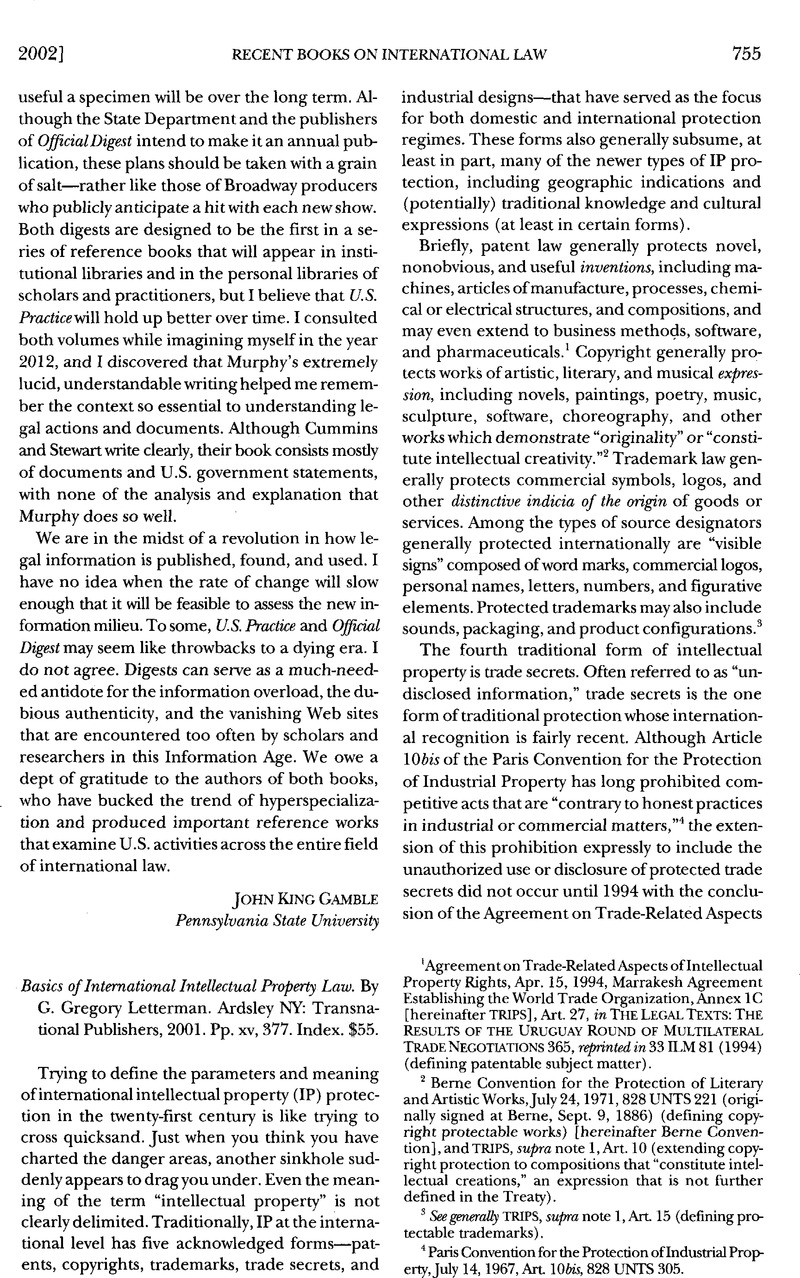No CrossRef data available.
Published online by Cambridge University Press: 27 February 2017

1 Agreement on Trade-Related Aspects of Intellectual Property Rights, Apr. 15, 1994, Marrakesh Agreement Establishing the World Trade Organization, Annex 1C [hereinafter TRIPS], Art. 27, in The Legal Texts: The Results of the Uruguay Round of Multilateral Trade Negotiations 365, reprinted in 33 ILM 81 (1994) (defining patentable subject matter).
2 Berne Convention for the Protection of Literary and Artistic Works, July 24,1971, 828 UNTS 221 (originally signed at Berne, Sept. 9, 1886) (defining copyright protectable works) [hereinafter Berne Convention] , and TRIPS, supra note 1, Art. 10 (extending copyright protection to compositions that “constitute intellectual creations,” an expression that is not further defined in the Treaty).
3 See generally TRIPS, supra note 1, Art. 15 (defining protectable trademarks).
4 Paris Convention for the Protection of Industrial Property, July 14, 1967, Art 10 bis, 828 UNTS 305.
5 See generally TRIPS, supra note 1, Art. 39 (defining protectable “undisclosed information”).
6 The term “utility model” is generally used to refer to industrial designs that are protectable as a type of “petit patent” and must demonstrate novelty (as opposed to originality) to receive protection.
7 See generally TRIPS, supranote 1, Art 25 (defining protectable industrial designs).
8 Accord AMP Inc. v. Utilux Proprietary Ltd., [1972] RPC 103 (H.L.).
9 Geographic indications identify the geographic source of a good whose particular quality or reputation is attributable to its geographic origin. See generally TRIPS, supra note 1, Arts. 22, 23 (defining the scope of protectable geographic indications).
10 See generally id., Art 35 (defining protectable topographies).
11 Welsh, Alexander, From Copperfield to Copyright 53 (1987)Google Scholar.
12 Supra note 2.
13 The Berne Convention, governing copyright, dates from 1886. The Paris Convention, governing patents, trademarks, trade secrets, and industrial designs, dates from 1883.
14 See, e.g., Friedman, Thomas, The Lexis and The Olive Tree (1999)Google Scholar; David, Held et al., Global Transformations: Politics, Economics and Culture (1999)Google Scholar.
15 Friedman, supra note 14.
16 Ministerial Declaration on the Uruguay Round, GATT Doc. Min. Dec. 86-1572 (Sept. 20, 1986), GATT B.I.S.D. (33d Supp.) at 19 (1987).
17 See generally Roundtable on Intellectual Property and Indigenous Peoples, WIPO Doc. WIPO/INDIP/ RT/98/4E (1998) (describing the patent on the quinoa of Bolívia’s Altiplano region granted to two U.S. researchers in 1994; the patent granted in 1996 on yage, a sacred plant of the indigenous people of Amazonia, to the International Plant Medicine Corporation of the United States; and the patent granted in the late 1980s to the French Institute of Scientific Research for Development in Cooperation for chimanines, a plant used by the Chimane tribe in the Amazon).
18 See WIPO Copyright Treaty, Dec. 20, 1996, Art. 11, S. Treaty Doc. No. 105-17 (1997), 36ILM65 (1997).
19 See Directive 2001/29/EC of the European Parliament and of the Council of 22 May 2001 on the Harmonization of Certain Aspects of Copyright and Related Rights in the Information Society, 2001 O.J. (L 167) 10.
20 See 17 U.S.C. §1201 (Supp. IV 1998).